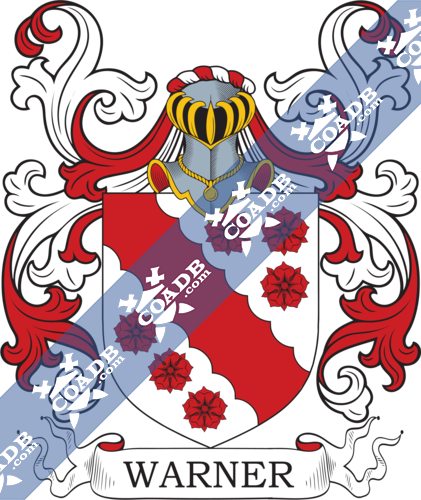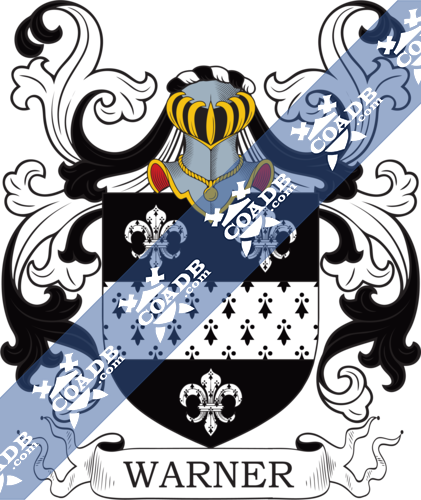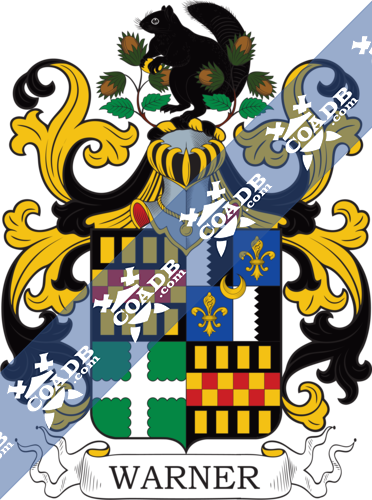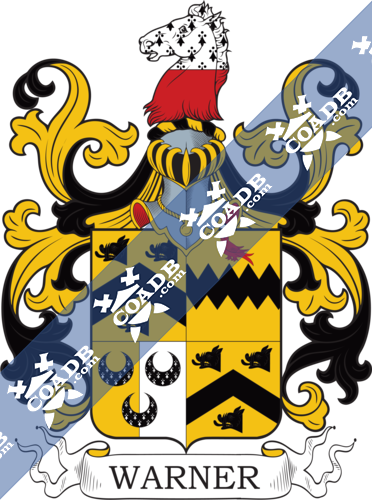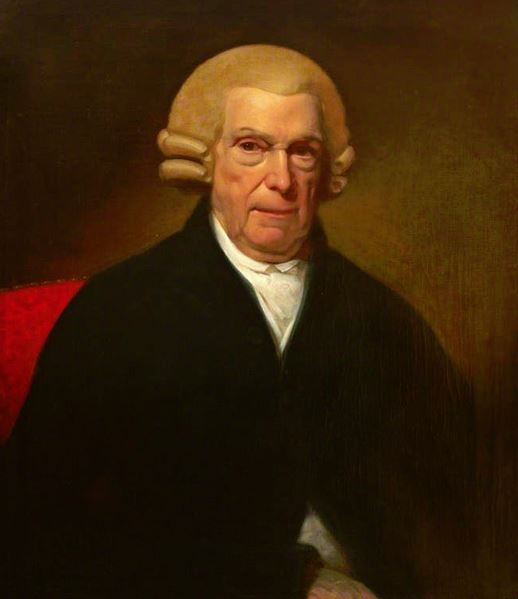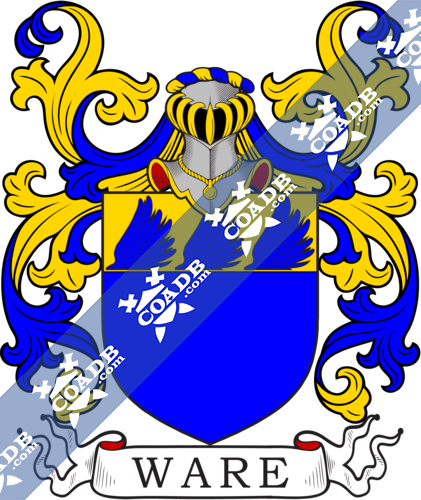Warner Family Crest, Coat of Arms and Name History

Warner Coat of Arms Gallery
Don’t know which Coat of Arms is yours?
We can do a genealogical research. Find out the exact history of your family!
Learn MoreWarner Surname Name Meaning, Origin, History, & Etymology
This last name has three separate origin theories. First, it is a baptismal or patronymic surname (“son of”) deriving from Warner, the Old French Garnier, Warnerus, and Warnerius. In this theory, it is an English name of Norman and North German origin, deriving from the Germanic personal (first) name that consists of the words warin (guard) and heri (army). The name was introduced into the British Isle during the Norman Invasion of 1066 AD in the form Warnier. Second, it is an official surname deriving from the title of “the warrener”, who was a keeper of a warren, which was a preserved ground or water for hares, rabbits, fish, and other animals, or in other words, the person served as a game warden for a hunting and fishing ground. In this theory, the name derives from the Anglo-Norman/French word warrene, meaning a warren, an area of land for breeding game (animals). It is interesting to note another source asserts the name means “protecting warrior”. Third, in some cases, it is an Anglicized version of the Gaelix surname O’Murnain or Murnane, found in records as Iwarrnane during medieval times.
Spelling Variations
Spelling variants or names with similar etymologies include Warnere, Warnar, Warinor, Warrener, Warrenener, Wariner, Wearner, Worner, Warnner, Werner (German) and others.
Popularity & Geographic Distribution
The last name Warner ranks 344th in popularity in the United Status as of the 2000 Census. The name ranks particularly high in the following six states: Ohio, Michigan, Utah, Minnesota, Connecticut, and Nebraska.
The surname Warner frequency/commonness ranks as follows in the British Isles: England (342nd), Scotland (855th), Wales (513th), Ireland (1,960th) and Northern Ireland (1,670th). In England, it ranks highest in Leicestershire. In Scotland, the surname Warner ranks highest in county Argyll. In Wales, it ranks highest in Radnorshire. In Ireland, it ranks highest in county Cork. In Northern Ireland, it ranks highest in Fermanagh.
The name is also present throughout the remainder English speaking world: Canada (796th), New Zealand (672nd), Australia (443rd), and South Africa (1,741st).
Early Bearers of the Surname
The earliest known bearer of this surname was Robert Warnier who was documented in the Pipe Rolls of Dorset in 1196 AD. Geoffrey was recorded in the Curia Rolls of Surrey in 1203 AD. Peter le Warner was recorded in the Curia Rolls of Yorkshire in 1214 AD. The Hundred Rolls of 1273 AD, a census of Wales and England, known in Latin as Rotuli Hundredorum lists two bearers of this surname: Richard le Warner (Cambridgeshire) and Jacke le Warner (Norfolk). Robert le Warner was documented in the Close Rolls in 172 AD. Eustace le Warner was recorded in the Excerpta e Rotulis Finium in Turri Londinensi. The Poll Tax of Yorkshire in 1379 AD lists one bearer of this last name: Henricus Warner. Early baptisms involving this name include Richard Warinor in Strouton, Wiltshire in 1572 AD and John, son of Ann Warrenener, at Kensington Parish Church in 1621 AD.
Warner Family Tree & Warner Genealogy
Warner of Ardeer
Patrick Warner, Esquire of Ardeer, county Ayr, Scotland, was a Justice of the Peace who was born in 1840. In 1864, he married Maude Louise, youngest daughter of Reverend T.J. Theobald, Rector of Nunnet, and fathered the following children with her: Patrick George, Harry Patrick Theobald, George Percy Macneil, Frederick, Louisa Forbes, and Lucy Lavinia Maude Robera. The Warner genealogy traces back to 1656, where John Warner, the first mentioned in the title deeds of this family, procured a tenement in the burgh of Irvine, together with the braid meadow adjacent from John Mure. He had two sons: Thomas and Patrick. His son Patrick was appointed Minister of Fort St. George in 1669 and he returned to Scotland in 1677 He was obtained Minister of Irvine where he officiated until 1709. In 1683, he married Mary, daughter of Reverend William Guthrie, and had daughters and a son with her. His son and heir was William Warner, Esquire of Ardeer who married Jane, daughter of Alexander Hamilton of Grange, and had a son named Patrick, his heir, as well as John and William. He died and was succeeded in 1762 by his son Patrick. Patrick married Helen Russell, and had three daughters and two sons with her. His son Patrick was his heir. This Patrick Warner was an Esquire of Ardeer, who was a Lieutenant in the Royal Navy, who in 1816, married Catherine, daughter of Quintin Johnston of Trolarg, and had issue with her named Catherine and Patrick. His son Patrick, a Justice of the Peace, was born in 1818, and in 1838, married Lucy Campbell, daughter of Captain Joseph Pearce, and had the numerous issue with her: Patrick, Joseph, William Frederick, Honyman George, James Patrick, Lucy Josephine, Forbes Anna Georgina, Catherine Elinor Mary, Anne Forbes (married Henry J. Patrick), and Octavia Helen. The Warner Coat of Arms (mistakenly called the Warner Family Crest) is blazoned in heraldry as follows: Azure, a fess between three boars’ heads erased argent. Crest: An open Bible proper. Motto: Manet in aeternum. They were seated at Ardeer House, Stevenson, county Ayr, Scotland.
Warner of Quorn Hall
The Warners of Framlingham, Cratfield, and Perham, Suffolk were a very ancient family in that county, and also in Essex, where they owned Warner’s Manor. Henry Warner, Esquire of Finchingfield, sold his manor of Warners to Richard, 1st Lord Rich, around the year 1550. It is assumed a branch of the family established itself after in the north of county Leicester, and became settled at Loughborough in the early 1700s AD. Thomas Warner, Esq. of Elm Park, the son of Thomas, married Harriet, daughter of John Handley, and had three children with her: Henry, Edward, and Harriet (married Richard Hole of The Hermitage). His son Edward Warner, Esquire of The Elms and Quorn Hall, county Leicester, and Kepwick Park, county York, was a Justice of the Peace and High Sheriff born in 1804. In 1848, he married Marianne, daughter of Reverend J.W.R Boyer, Rector of Swepstone-cum-Snareston, by Charlotte, his wife, daughter of Rev William Pochin, and had four children with her: John Henry Boyer (1849, Justice of the Peace), Edward Handley (1850, Justice of the Peace, married Jessie Nancy Brooks), William Pochlin (1854, 18th Hussars), and Charlotte Elizabeth. He procured Quorn Hall from Sir Richard Sutton in 1854. The Warner Coat of Arms (mistakenly called the Warner Family Crest) is blazoned in heraldry as follows: Or, a bend engrailed gules between six roses of the last barbed vert. Crest: On a mural crown a squirrel sejant cracking a nut all proper. This branch of the Warner family tree was seated at Quorn Hall and the Elms in Loughborough and also Kepwick, Northallerton, York, England.
Warner of Highams
The lineage of this family traces back to Edward Warner, Esquire of Higham Hall, married Sarah, daughter of Reverend R. Brooke of Cottingham, and died in 1815, having fathered two children with her: Thomas (succeeded his father but died in 1823) and Edward (succeeded his brother). The latter, Edward Warner, Esq., in 1817, married Anny Mary, daughter of George Pearson of Jamaica, and had three issue with her: Edward, Thomas Courtenay (married Elizabeth, daughter of Richard P. Harris), and Ann Mary. He died in 1847 and was succeeded by his eldest son, Edward. Edward was an Esquire of Highams, Essex, and Justice of the Peace for Essex, Middlesex, and Westerminister, as well as Deputy Lieutenant for Essex, and a Member of Parliament for Norwich. He was born in 1818, and in 1848, he married Maria, daughter of Thomas Carr of New Ross in Wexford, Ireland, and had two issue with her: Thomas and Eleanor Anne (married Baron Richard von Schmidthals in 1866, Secretary of the Prussian Legation, Stockholm, and later part of the North German Embassy in London). His son Thomas Courtenay Theydon Warner, Esquire of Highams in Essex, England, was born in 1857.
Baronet Warner
The lineage traces back to Edward Warner, of Theydon Bols, Essex, England, who married a woman named Anne and had a son with her, also named Edward. This Edward was of Leyon, Essex, and he married Sarah, daughter of Reverend R. Brooke of Cottingham, and had two children with her: Thomas Courtenay and Edward. The second son, Edward Warner, was of the Clock House, Walthamstow, and was born in 1771. In 1817, he married Ann Mary, daughter of George Pearson of Jamaica, and had issue with her, including a son named Edward. This Edward was of Highams, Walthamstow, and Essex and was a Justice of the Peace, Deputy Lieutenant, and Member of Parliament. In 1848, he married Maria, daughter of Thomas Carr of New Ross, and had two issue with her: Edward and Sir Thomas. The latter, Sir Thomas Courtenay Theydon, was created a Baronet in 1910. Sir Thomas was the 1st Baronet. He was High Sheriff, an Alderman, a Member of Parliament, a Colonel in the Suffolk Volunteers Regiment, and held several other positions/titles. Un 1883, he married Lady Leucha Diana Maude, daughter of the 1st Earl de Montalt, and had issue with her: Edward Courtenay, Cornwallis John (Lieutenant who served in World War I), Thomas Seymour Marius (married three times and had issue), Lilian Georgiana (married Lieutenant David Archibald James Chapman and later Charles Ronald Mansel Lewis), and Leucha Mary. His son, Sir Edward Courtenay Thomas Warner, 2nd Baronet, of Brettenham Park, Suffolk, England was born in 1886 and succeeded his father in 1934. He was educated at Eton and Oxford and was a Deputy Lieutenant and Justice of the Peace for county Suffolk, England, as well as High Sheriff in 1947. He was a Colonel in the Scots Guards and served in World War I and II. In 1920, he married Nesta Douglas-Pennant, daughter of Baron Penrhyn, and had three issue with her: Edward Courtenay Henry (Lieutenant of Scots Guards, wounded in World War II), Anne Philippa (born 1927), and Leucha Daphne Mary (born 1929). This branch of the Warner family tree was seated at Brettenham Park, Suffolk, England. The Warner Coat of Arms (sometimes erroneously referred to as the Warner Family Crest) has the following heraldic blazon: Per bend argent and gules, two bendlets between six roses all counterchanged. Crest: A Saracen’s head affrontee couped at the shoulders proper vester gules on the head a cap chequy argent and gules, in the front thereof three roses also argent.
Other Warner Pedigree & Family Tree
Gilbert de Wetenhale was born in Hankelow, Chesire, England, sometime before 1259 AD. The following is the pedigree from him:
NN. de Whetenahll (born around 1200 AD)
John, Lord of Wetenhale (born in Cheshire, England around 1264 AD)
Sir John de Wetenhale (born in Acton, Cheshire around 1295 AD)
Sir James Whetenhall (born around 1324 AD)
Sir Edward Whetenhall (born in Great Waltham, Essex around 1340 AD)
John Le Warner (born in Great Waltham around 1370 AD)
John Warner (born in Great Waltham, Essex, around 1396 AD)
John Warner III (born around 1418 AD)
Henry Warner Senior (born in Great Waltham around 1479 AD)
Stevin Thomas Warner (born in Great Waltham around 1500 AD)
John Warner Sr. (born in Great Waltham, Essex around 1542 AD)
John Warner of Hatfield Broad Oak (born in Hatfield Broad Oak, England around 1568)
Andrew Warner (born 1595 in England, came to Hadley, Massachusetts Bay Colony, colonial America)
This Andrew Warner had numerous issue, including: Mary (Hills), John, Andrew Jr. Robert, Hannah, Robert, Ruth, Daniel Sr., Isaac, John of Fairfield, Andrew, and others. His son Thomas was born in Hartford, Connecticut in 1705. He married Delight Metcalf, and had two issue with her: Eleazer and Alice (Cross). His son Eleazer was born in Ashford, CT in 1738 and he married Joanna Hale, with whom he had three issue: Thomas, Zachariah, and Abigail. His son Thomas was born in the same town in 1764. He married Rhosa Hopkins and had a daughter with her named Joanna. Joanna was born in New Lisbon in 1804, and she married Namaan Cone, with whom she had a son named Eleazur T. Cone, born in 1835.
A one William Warner was born around 1380 AD. He had a son named Nicholas who was born in Fressingfield, Suffolk, England around 1400. He had a son named Thomas. Thomas was born in the same town around 1430 and he had three issue: Johan (Aldous), John, and Alice.
Early American and New World Settlers
Joseph Warner, age 20, came to New England aboard the Increase in April 1635.
Thomas Warner, age 26, came to Virginia aboard the Thomas & John in June 1635.
Ciprian Warner, age 21, came to Virginia aboard the Paule of London in July 1635.
Thomas Warner, age 12, came to Virginia aboard the Paule of London in July 1635.
William Warner, age 25, came to Virginia aboard the Globe in August 1635.
Nathaniell Warner came to Jamaica aboard the Unity in December 1679.
Ralph Warner was buried in the parish of St. Michael’s, Barbados in April 1678.
John, son of Thomas and Ann Warner, was buried in the aforementioned parish in June 1678.
Sir Thomas Warner, Knight, was buried in aforementioned parish in July 1679.
Samuell Warner owned 10 acres and 8 slaves in the Barbados in the late seventeenth century.
Other early settlers in colonial America bearing this surname include Augustine Warner (Virginia 1628), Andrew Warner (Massachusetts 1631), William Warner (Boston 1631), Barbara Warner (Virginia 1714), Hendrich Warner (Pennsylvania 1729), Johann Adam Warner (Philadelphia 1734), and Henrick Warner (Pennsylvania 1741).
In Canada,one of the earliest bearers was Christopher Warner who came to Nova Scotia in 1750. In Australia,one of the first persons with this last name was Francis Warner, a convict from Nottingham, England who came aboard the Arab in 1822 and settled in Van Diemen’s Land (modern day Tasmania). In New Zealand, one of the earliest bearers was Richard Warner, who came to Nelson aboard the Olympus in 1842, a 23 year old blacksmith.
Early Americans Bearing the Warner Family Crest
Charles Bolton’s American Armory (1927) contains one entry for this surname: Vert a cross engr or. Old silver of descendants of Col. Augustine Warner, “Warner Hall,” Va., 1628. Crozier Va. Heral., p. 58. Wm. & Mary Quar., Jan 1894, p. 156.
Crozier’s General Armory (1904) contains four entries for this name:
1) Virginia. Vert, a cross engrailed or.
2) Andrew Warner of Cambridge, Massachusetts, from Herfordshire, England, 1632. Arms: Or, a bend engrailed between six roses gules. Crest: A Saracen’s head affronte wreathed.
3) Mrs. Carlow Warner of Ne York. For arms see Robert Seeley of Watertown, MA (Sable, a lion rampany or between two flaunches argent. Crest: A lion rampant or).
4) Mrs. Elma Seeley Warner of New York. For arms see Robert Seeley of Watertown, MA (Sable, a lion rampany or between two flaunches argent. Crest: A lion rampant or).
Matthew’s American Armoury (1907) and Bluebook contains one entry for this name: John de Witt Warner of New York City, who was born near Watkins, NT in 1951. He graduated from Cornell and was a member of Congress. In 1877, he married Lilian A., daughter of Joseph Parshall and Harriet C. Hudson, and had two issue with her: Joseph DeWitt (1881) and Charlotte Lilian. His arms were blazoned as follows: Or, a ben engrailed between six roses gules, barbed vert. Crest: A man’s head proper couped below the shoulders habited chequy or and azure, wreather or and gules, on the head a cap argent. He was the son of Daniel De Witt Warner and Charlotte F. Coon. He was a descendant of John Warner of Hatfield, Gloucester, England.
Mottoes
I have identified five Warner family mottoes:
1) Non nobis tantuni nati (We are not born for ourselves alone)
2) Spero (Hope)
3) Deo adjuvante non timendum (With the help of God, there is nothing to fear)
4) Candider et constanter (Fairly and firmly)
5) Manet in aeternum (It endureth for ever) (Warner of Ardeer in county Ayr, Scotland)
Grantees
We have 24 coats of arms for the Warner surname depicted here. These 24 blazons are from Bernard Burke’s book The General Armory of England, Ireland, and Scotland, which was published in 1848. The bottom of this page contains the blazons, and in many instances contains some historical, geographical, and genealogical about where coat of arms was found and who bore it. People with this last name that bore an Warner Coat of Arms (or mistakenly called the Family Crest)
1) Warner (Lee-), late Woodward, Daniel Henry, of county Norfolk, 5 March 1806
2) Warner (Lee-), late Bagge, William W., 2. Edward, 3. Arthur, 4. Thomas, sons of Charles Elsden Bagge, M.D., Royal License, 21 May 1814
3) Edward Warner Highams, Member of Parliament of Walthamstow, county Essex, 1859
Notables
There are hundreds of notable people with the Warner surname. This page will mention a handful. Famous people with this last name include: 1) Aaron “Albert” Warner (1884-1067) who was a Polish-born Jewish and American film executive who with his three other brothers founded the famous Warner Brothers Studios, 2) Augustine Warner Sr. (1610-1674) who was a politician and planer from Virginia born in Norwich, England, who became a Speaker of the House in Virginia in 1676 and was the great-great grandfather of President George Washington, 3) Fred Maltby Warner (1865-1923) who was the 26th Governor of Michigan from 1905-1911, 4) Kurtis Eugene Warner (1971) who was an American football quarterback born in Burlington, Iowa who played for four different NFL teams and won the Superbowl once in 1999, 5) Charles Dudley Warner (1829-1900) who was an American novelist and essayist born in Plainfield, Massachusetts who co-authored The Gilded Age with his friend Mark Twain, 6) Volney Frank Warner (1926) who was a four-star General in the United States Army who was born in Woonsocket, South Dakota, 7) William Warner (1840-1916) who was a Senator from Missouri from 1905-1911 and was born in Shullsburg, Wisconsin, 8) Sylvia Townsend Warner (1893-1978) who was an English poet and novelist from Harrow on the Hill, Middlesex, 9) Sir Thomas Warner (1580-1649) who was an English explorer in the Carribbean who established a colony on Saint Kitts in 1642, 10) Seth Warner (1743-1784) who was a Revolutionary War officer from Vermont who is best known for his capture of Fort Crtown Point during the siefge og Quebec, and 11) Susan Bogert Warner (1819-1885) who was an American evangelical writer of religious fiction and other works, born in New York City.
Blazons & Genealogy Notes
2) (Waltham, co. Essex, and co. Sussex, 1609). (London). Or, a bend engr. betw. six roses gu. barbed vert. Crest—A man’s head ppr. couped below the shoulders, habited chequy or and az. wreathed about the temples gold and gu. on the head a cap ar.
3) (London). Ar. on a chev. gu. betw. three ravens’ heads erased sa. as many mullets pierced or.
4) (London, co. Norfolk, and Peterborough). Per bend indented sa. and ar. Crest—A double plume of feathers or.
5) (co. Kent; granted by Segar, Garter, 1616). Quarterly, 1st and 4th, per pale indented ar. and sa.; 2nd and 3rd, az. a fleur-de-lis or. Crest—A double plume of feathers ar.
6) (Strowd, co. Middlesex; Mark Wakner. son of Robert Wabner, grandson of John Warner, great-grandson of John Warner, Alderman of London. Visit. London, 1568). Quarterly, 1st and 4th, or, achcv. betw. three boars’ heads couped sa.; 2nd, or, a fess dancettee sa. in chief a martlet gu., for Vavasour; 3rd, per pale or and ar. three crescents ermines. Crest—A horse’s head erased per fess erm. and gu.
7) (co. Norfolk). (Thame, co. Oxford; arms on a monument in Thame Church). Vert a cross engr. Or
8) (co. Suffolk). Erm. on a cross raguly sa. five estoiles or. Crest—A lizard vert.
9) (co. Suffolk). Per bend indented ar. and sa.
10) (Ratcliff and Rowington, co. Warwick). Or, a chev. betw. three boars’ heads erased sa. Crest—A horse’s head erased per fess erm. and gu. maned also gu.
11) (Warner Hall, Brakenthwaite, and Knaresborough, co. York). Or, a bend engr. betw. six roses gu. Barbed vert. Crest—A Saracen’s head affrontee ppr. wreathed round the temples or and gu.
12) (Walthamstow, co. Essex). Per bend ar. and gu. two bendlets betw. six roses all counterchanged. Crest—A Saracen’s head affrontee couped at the shoulders ppr. vested gu. on the head a cap chequy ar. and gu. in front thereof three roses ar. Motto: Spero.
13) (Dr. Ferdinando Warner, d. 1768). Ar. a cinquefoil gu. in chief a crescent for diff.
14) Ar. a chev. gu. betw. three mullets pierced sa.
15) Az. three fleurs-de-lis ar. a border of the last.
“16) Az. a fess wavy ar. guttee de sang, in chief two crosses crosslet fitchee and in base a crescent of the
second.”
17) Ar. (another, or), a bend engr. betw. six roses gu.
18) Sa. a fess betw. three fleurs-de-lis erm.
19) Or, a chev. betw. three boars’ heads couped sa.
20) Or, a bend engr. betw. six cinquefoils gu.
21) (granted by Bysshe, Garter, 1666. Visit. Kent). Quarterly, 1st and 4th, sa. a fess componee counter-componee or and gu. betw. eight billets of the second; 2nd, quarterly, 1st and 4th, per pale indented ar. and sa., 2nd and 3rd, az. a fleur-de-lis or, a crescent for diff.; 3rd, vert a cross engr. ar. Crest—A squirrel sejant sa. betw. two hazel branches ppr. cracking a nut or.
22) (John Warner, Bishop of Rochester, 1638-66; arms from his monument). (Lee-Warner, Walsingham Abbey, co. Norfolk; Thomas Lee, a descendant of Lee, of Cotton, co. Salop, m. Anne, sister of John Warner, Bishop of Rochester, 1638-66. Their great-grandson, Henry Lee, assumed the additional surname of Warner; his son, Henry Lee-Warner, Esq., of Walsingham Abbey, d. unm., and left his estates to his cousin, Henry Woodward, Esq.). Motto—Non nobis tantum nati. Quarterly, 1st and 4th, per pale indented ar. and sa.; 2nd and 3rd, az. a fleur-de-lis
23) (Lee-Warner, Walsingham Abbey and Tiberton Court, co. Hereford; Henry Woodward, son of Daniel Woodward, Esq., by Mary his wife, dau. of Rev. Richard Huntley and Anne his wife, sister of Henry Lee-Warner, Esq., of Walsingham, having s. to the estates of his cousin, Henry Lee-Warner, assumed the surnames of Lee-Warner in lieu of Woodward, and d. 1835). Quarterly of six, 1st, sa. a fess componee counter-componee or and gu. betw. eight billets of the second; 2nd, quarterly, 1st and 4th, per pale indented ar. and sa., 2nd and 3rd, az. a fleur-de-lis or; 3rd, vert a cross engr. ar.; 4th, ar. a fess sa. betw. three wolves’ heads erased ppr.; 5th, erm. three scymitars ppr. hilts and pommels or; 6th, ar. on a cross sa. a leopard’s face or. Crest—A squirrel sejant betw. two hazel branches cracking a nut all ppr. The crest is sometimes borne with the squirrel sejant on the trunk of a tree ppr. betw. a hazel and oak branch. Motto—Hon nobis tantum nati.
24) (Dublin; confirmed, 1813, to George Warner, Esq., of Dublin, High Sheriff of that city, and to the descendants of his ancestor, Edward Warner, Esq., of Woodvills, co. Cork, son of Rev. Thomas Wabner, D.D., Rector of Balsham, co. Cambridge, who settled in Ireland temp. Charles I.). Ermines on a cross engr. or, five mullets vert. Crest—An heraldic tiger pass. gu. Motto—Deo adjuvante non timendum.




